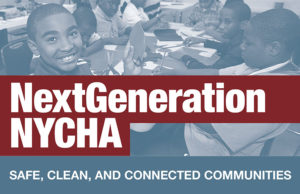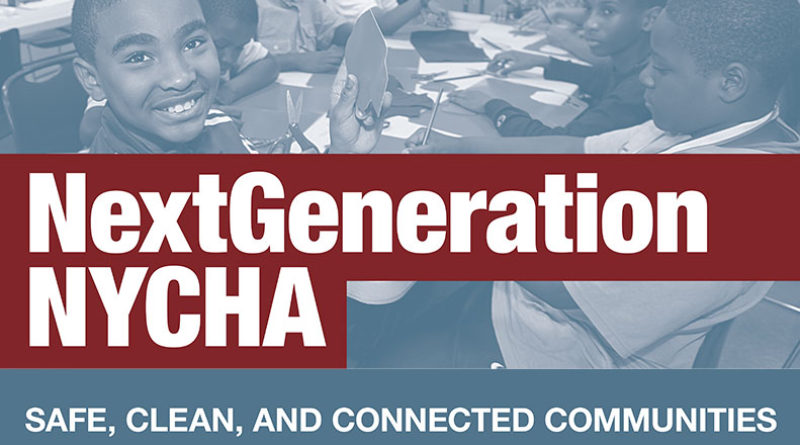NextGeneration NYCHA: Frequently Asked Questions

What is NextGeneration NYCHA?
NextGeneration NYCHA is a ten-year strategic plan that will guide NYCHA in changing the way we do business. We understand that NYCHA residents, like all New Yorkers, want communities that are safe, clean and connected. To create and sustain those communities, NYCHA must make fundamental changes to our business model. NextGeneration NYCHA will address how NYCHA is funded, operates, and engages with residents.
Why is NYCHA developing a plan?
Chronic underfunding has hindered NYCHA’s ability to do a good job. From 2001 through 2013, Congress underfunded NYCHA by nearly a billion dollars in capital funds and another billion dollars for repairs and maintenance. Faced with this reality, NYCHA must often make hard choices that we know leave residents disappointed or discontented.
What does underfunding mean to residents?
It means that roofs, elevators, heating systems and facades do not get needed maintenance, repair, or replacement, especially as buildings continue to age. About 80 percent of NYCHA’s buildings are 40 years old or older. Delayed repairs to the infrastructure of NYCHA’s buildings become ever bigger problems the longer they remain unrepaired. Ongoing upkeep of building systems and structures is essential to keep buildings and apartments habitable. Moreover, the longer repairs are delayed, the more extensive and expensive they become.
How is NextGeneration NYCHA different from Plan NYCHA?
NextGeneration NYCHA builds on the successes of previous five-year plans, including the Plan to Preserve Public Housing (2006) and Plan NYCHA (2011), which led to work order reductions, CCTV and layered access installations, moving Section 8 income recertification online, and increased customer service positions. However, from the beginning, the methods we used to create NextGeneration NYCHA differed from previous strategic planning processes. NextGeneration NYCHA incorporated more input from a wider variety of stakeholders at many different stages of plan development. Our stakeholders will continue to help us refine our work as the plan progresses.
How was the NextGeneration NYCHA plan created?
NextGeneration NYCHA is both a plan and a process. The plan was crafted with input from over 1,000 NYCHA residents plus employees, community and government partners, and advocates. When the Mayor charged us to reset our relationship with our residents and engage them in the decision-making process, NYCHA engaged in a listening tour involving more than 5,000 staff, over 2,000 residents at 85 development visits and stakeholder meetings, the NYCHA Board, the Citywide Council of Presidents and Resident Advisory Board, Resident Association presidents, governmental agencies, elected officials, advocates, industry groups, lenders and investors, affordable housing experts, philanthropic organizations, service providers, other public housing authorities, and third-party property management groups. We then held a series of meetings at each of three developments— Mill Brook, Ingersoll and Van Dyke — to listen, gather and document specific ideas for improvements and changes, all of which are a part of NextGeneration NYCHA. These community visioning sessions involved more than 900 participants and resulted in three NextGeneration NYCHA Community Vision Plans. From there, residents formed six community committees at each development and are now in the process of putting their plans in action.
When will the plan start?
We have already begun to transform our operations through a NextGeneration NYCHA lens:
- The Mayor’s forgiveness of our police fees provided the funds to install 49 additional CCTV projects in 2014.
- In January 2015, we launched a new operating model at 18 developments to improve customer service and response time by shifting decision-making on budgeting and purchasing to development property managers. As employees become more empowered to make good management decisions for their developments, residents will also see more accountability.
- A new recycling initiative launching in May 2015 will make our developments more sustainable while improving quality of life for residents. Through this collaborative effort with the Department of Sanitation, NYCHA will be in compliance with the City’s Recycling Law by the end of 2016.
- Our public/private partnerships continue to model the power of collective impact—a commitment from residents and key stakeholders, to a common agenda and clearly defined goal, for solving a complex problem. For example, in March we graduated 20 NYCHA residents from an innovative food business incubator program created with partners including Citi, NYC Small Business Services, NYC Economic Development Corporation, and Hot Bread Kitchen. Five of those participants are already in the process of launching their own businesses!







